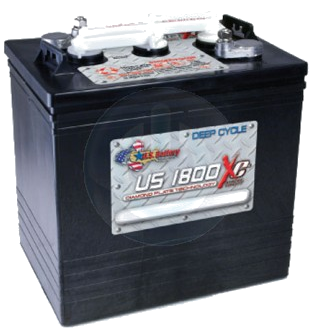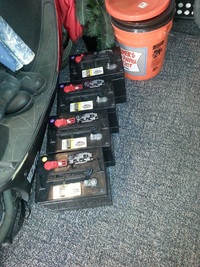Reserve capacity is, according to some, the only useful and meaningful measure of a battery's quality. Cold-cranking Amperes, Ampere-hours, etc. are misleading and mostly useless terms.
Reserve capacity is precisely the number of minutes the fully charged battery will deliver 25 Amperes before being depleted.

Every battery is designed for a specific type of charge and discharge cycle. Car batteries have thin plates to keep their weight down and are designed for a heavy discharge lasting a few seconds, followed by a long period of slow recharge.
A 6-volt golf-cart battery (size T-105) is the minimum recommended battery for a residential solar application. Buy them in "pairs" to make 12 volts. Golf cart batteries have very thick plates and are designed for hours of heavy discharge each day, followed by a fast recharge in only a few hours each night.
This is similar to the duty cycle of a residential solar application, only in reverse. A solar battery must be able to provide long periods of deep discharge each evening and night, followed by a full recharge in only a few hours of sunlight each afternoon. Very few batteries can take a deep discharge-recharge cycle every day, and the 6-volt golf-cart battery is the least expensive and easiest to find locally that can do this.
A typical 6-volt golf-cart battery will store about 1 kiloWatt-hour of useful energy (6 volts×220 ampere-hour×80% discharge = 1056 Watt-hours).
Ampere-hours or Watt-hours is a human-understandable rating. For example, if you turn on a light-switch powering a bright, 100-Watt bulb in your house (of the old, incandescent variety), you are consuming 100 Watts every hour. If you were running that light bulb off a battery, not accounting for the loss and ineffeciency that creates, and your battery was capable of 1056 Watt-hours, then you could run that light for about 10½ hours.
Since the aforementioned set-up would only power one 100-Watt incandescent bulb for 10 hours (100×10 = 1000 Watt-hours), your alternative energy system will most likely require wiring several batteries together to create a battery bank. Since each golf-cart battery weighs almost 65 pounds, there are weight considerations as well as battery gas venting issues to think about. (Don't even think of putting these in your house.)
If you need more than the 220 amp-hour capacity contained in each golf-cart battery, you could entertain switching to the larger "L-16" size traction battery (not discussed here), which has a 350 amp-hour rating and may allow using fewer batteries. This battery is the same length and width as a golf-cart battery, but is much taller and twice as heavy (and more expensive). It's an excellent battery for solar applications and can endure very heavy charge-discharge cycling. This industrial rated battery may be more difficult to find, as it is only available from battery wholesale distributors.
A local automotive expert tells me that the difference between batteries for cars verses these batteries is that car batteries are asked to supply a great deal of current (Amperes) for short bursts under difficult (usually cold) conditions. Car batteries are not deep-cycle. Golf-cart batteries are called on to produce adequate amounts of power over extended periods of time and do not need the brute, "cold-cranking amps" of car batteries that car battery marketers extoll so heavily.
For this reason, using car batteries is not as good a solution for off-grid storage as golf-cart batteries.
Systems are typically constructed using either 12 or 24 Volts. The former uses components most people are familiar with, understand since cars use 12-Volt batteries and more available.
24-Volt systems are more efficient and there is less loss. Incidentally, the reason Europe chose to rebuild their electrical systems as 220-Volt after the War was precisely for this reason. Anyone who's spent any time there has noticed how power cables for appliances look "cheap" because they're thinner. Indeed, this isn't because they are of lower quality at all, it's because using twice the intensity of current, appliances in Europe do not require the heavier gauges needed in countries running 110-Volt systems.
It's possible to purchase 24-Volt panels and components though you have to look a little harder for them.
Batteries can lose over half of their charge when exposed to extreme temperature swings, so be sure your proposed battery location stays in a 50° to 80° F range, or you will need to insulate the battery box. Since liquid batteries require refilling and battery terminal cleaning to remove corrosion several times each year, the floor area selected should be able to take an occasional acid spill and water wash down.
Battery venting is very important. If you build an enclosure around your batteries, it should be designed to direct all vented gases to the outside. A 2" PVC pipe makes a good vent, but be sure it is located at the highest point in your battery enclosure where the lighter hydrogen gas will accumulate. Be sure it also includes a screened vent cap to keep out rain and insects. Do not locate your battery bank near a gas water heater or other open flame appliance that could ignite any accidental hydrogen accumulation.

I purchase 4 6-Volt Interstate golf-cart batteries for $83.99 each plus $15 core charge which they say they will refund any time I bring in a suitable old car battery and show my receipt. (Click on the image to the right for a larger view.)
Looking on-line for Interstate batteries, I see them mostly up around the $150 range. The markings and product color are different, but the tops of the illustrations look identical. There is a dearth of useable information about these batteries even in the Specifications tab. The description includes statements about them being "deep-cycle." Reviewers often admit they're using them for solar energy installations and are pleased with them.
The Costco guy who does tires and batteries told me that historically Costco golf-cart batteries carried the Kirkland logo, but were made by Johnson Controls before they chose Interstate as the supplier. On-line research tells me that some bloggers were proclaiming Johnson Controls in 2009. Recently, the Kirkland branding was dropped and Costco batteries now clearly say Interstate.
A Costco employee told me that he was around when the switch was made. Johnson Controls had begun having their batteries built on the cheap in some country south of the border. Perceptible quality suffered; Costco experienced many warranty issues and complaints. The switch-over to Interstate happened very quickly from the employees' point of view. Complaints have dropped precipitously since the change.
(I may come back and discuss these.)
Always wear eye protection and acid proof gloves when working around batteries, and have lots of water and baking soda nearby. This will neutralize any acid spills from battery refilling and prevent further corrosive damage.
Over-charging batteries is what the charge-controller component of your solar power system is meant to prevent. Over-charging batteries damages them and shortens their life.
Over discharging batteries is depleting them to below 50% of their charged capacity significantly shortens their cycle life. Your charge-controller is built to prevent this.
Infrequent or inadequate charging can also shorten the life of a battery while also gradually diminishing its capacity. This often happens to motorcycle batteries, especially when stored over winter, and also batteries in toy equipment that's not frequently used.